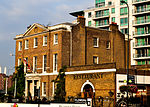St George Wharf
Buildings and structures in the London Borough of LambethBuildings and structures under construction in the United KingdomLondon geography stubsRedeveloped ports and waterfronts in LondonUse British English from December 2017 ... and 1 more
Vauxhall

St George Wharf is a riverside development in Vauxhall, Lambeth, London, England, located on the southern bank of the River Thames beside Vauxhall Bridge. St George Wharf Pier is a calling point for London River Services riverboat RB2 and RB6 services. The 93,000-square-metre (1,000,000 sq ft) mixed-use development is located between the Vauxhall Cross road junction and the river, and is near Vauxhall station. The River Effra, one of the Thames' many underground tributaries, empties into the river close by. This development should not be confused with the smaller St George's Wharf which is in Shad Thames, London SE1, close to Tower Bridge.
Excerpt from the Wikipedia article St George Wharf (License: CC BY-SA 3.0, Authors, Images).St George Wharf
A202, London Vauxhall (London Borough of Lambeth)
Geographical coordinates (GPS) Address Nearby Places Show on map
Geographical coordinates (GPS)
| Latitude | Longitude |
|---|---|
| N 51.485555555556 ° | E -0.12611111111111 ° |
Address
Flagstaff House
A202
SW8 2LL London, Vauxhall (London Borough of Lambeth)
England, United Kingdom
Open on Google Maps







